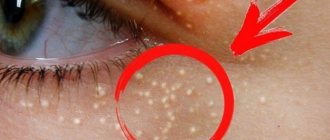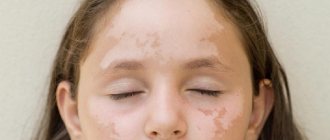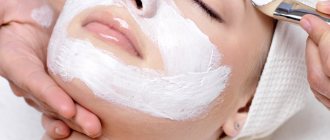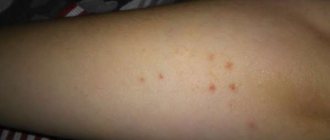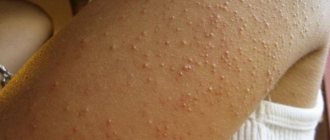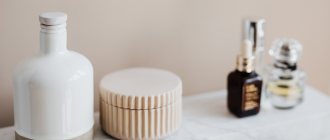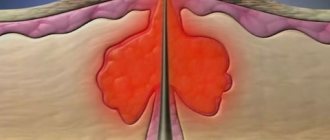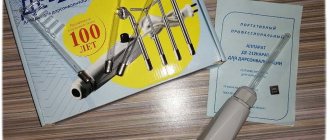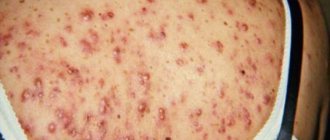The main reasons for the appearance
Milia most often appear near the eyes.
Small formations on the skin of a white-yellow color, filled inside with subcutaneous fat and keratin, which do not cause painful or unpleasant sensations, are called milia or millea.
Most often they appear on the face in the area of the nasolabial triangle, near the eyes, and on the chin.
Medicine cannot give an exact answer to the question of why millet grasses form. They make the following assumptions:
- imbalance of major hormones in the body;
- disorders of the thyroid and pancreas;
- gastrointestinal diseases;
- improper diet;
- poor skin care;
- increased sebum production;
- exposure to UV rays.
As a rule, milia open on their own after 5 to 7 days. If they constantly appear and do not disappear for a long period of time, this is a reason to conduct a comprehensive examination of the entire body!
Etiology
Milia on the face or any other location are a cystic neoplasm located at the mouth of the hair follicle and looking like a small white grain.
Such acne, during the course of specific processes, is a sebaceous gland or vellus hair follicle, which is hermetically sealed with sebum and horny masses.
It is worth noting that the sebaceous glands begin to form in the third month of intrauterine development of the fetus, and any negative factors affecting the female body during pregnancy lead to single or multiple milia in newborns. It is noteworthy that as the baby grows, the number of small white pimples decreases, which means that they disappear on their own without a trace.
The second peak incidence occurs in adolescents during puberty. In such situations, improper sebum regulation or sloughing of dead skin cells may result in small white nodules. Such violations can be caused by:
- the course of a thick form of oily seborrhea - this disease is characterized by hyperfunctioning of the sebaceous glands and a change in the chemical composition of sebum;
- an increase in the level of sex hormones, in particular androgens;
- dysfunction of the autonomic nervous system;
- lack of vitamins in the human body;
- improper skin care or complete lack of hygiene measures;
- hyperkeratosis of the hair follicle;
- poor nutrition – this includes excessive addiction to fatty, salty and spicy foods, smoked meats and preservatives, sweets and carbonated drinks;
- using low-quality cosmetics;
- severe drying of the skin due to certain cosmetic procedures;
- indiscriminate use of medications, which have dry skin among the side effects;
- the occurrence of inflammatory processes on the skin;
- injury to the skin during peeling, laser therapy or surgery;
- prolonged exposure of the skin to sunlight or ultraviolet radiation;
- frequent visits to solariums;
- benign neoplasms of skin appendages;
- addiction to bad habits.
Milia in children and adults can also be caused by a wide range of ailments that negatively affect the condition of the skin. This category includes:
- porphyria cutanea tarda;
- bullous pemphigoid;
- dystrophic epidermolysis bullosa;
- lupus of tuberculous nature;
- sarcoidosis;
- pathologies of the gastrointestinal tract and endocrine system.
Clinical manifestations
Milia in children and adults is only a cosmetic defect that does not affect the quality of life. However, it is worth highlighting some features of whiteheads that make it possible to distinguish them from similar skin rashes:
- are formed gradually and absolutely painlessly;
- not prone to merging into one large spot;
- more often they are formed in groups, although the presence of 1-2 separate points is not excluded;
- cysts are light in color, sometimes with a yellow tint;
- never grow larger than 3 mm;
- They never become inflamed on their own, because accumulated sebum does not have direct access to the surface of the skin. The only exception to this rule is when pathogenic bacteria enter the eel for some reason. In this case, inflammation develops, and the milium itself transforms into an abscess;
- do not grow for a long time;
- often appear only on the face.
The most common places to see whiteheads are:
- on the nose (in 90% of cases it is diagnosed in infants);
- on the eyelid (here white dots rarely occur in single copies);
- on the cheeks and forehead;
- in the paraorbital zone;
- in the area of the cheekbones and temples.
In addition to the usual places where milia are localized, there are areas where small white dots are formed extremely rarely:
- under the eyes;
- on the lips;
- on the limbs;
- on the genitals;
- in other parts of the body.
All patients who are faced with a similar cosmetic defect should remember that they cannot squeeze out the acne themselves. Aggressive actions will lead to injury not only to the skin, but also to the sebaceous gland itself. As a result, amateur activity will lead to the formation of a huge blackhead, inflammation and the formation of a rough scar.
Classification and localization
- The main area of localization of millet is the face. Most often it appears in the area of the eyes, chin, and nose. It is extremely rare that millet appears in the genital area, on the nipples.
- There are two types of milia: primary and secondary. The classic form of primary millet can be observed in newborns. This is a physiological phenomenon that does not require treatment.
- The defect occurs at any age, more often in men than in women. For women, the appearance of milia is typical at the time of puberty and menopause, when hormonal changes occur in the body.
Primary milia under the eyes (photo)
Salon removal techniques
Only a cosmetologist or dermatologist can recommend the best way to remove grasses depending on their location, their total number, proximity of blood vessels, skin type, and so on.
Modern cosmetology offers the following types of techniques for eliminating milia:
- a mechanical method of removal, most often carried out in beauty salons. For this purpose, thin surgical needles that have undergone antiseptic treatment are used, with the help of which the millet is pierced, their contents come out, and the skin in this place is thoroughly disinfected. In one session, it is allowed to remove about 10 milia to prevent injury to the skin surface;
- electrocoagulation, used in cases where the patient is afraid of puncturing the skin with a needle. This method is no less popular than the previous one. Its essence is the direct effect on the affected skin of low-power and high-frequency alternating current electrical impulses. The current, penetrating under the skin, destroys the accumulation of subcutaneous fat, which instantly comes to the surface. Immediately after the session, a crust appears in the treatment areas, which disappears on its own over the next few days. This method of removal involves special home care for the epidermis, which consists of regularly treating damaged skin with antiseptic solutions;
- laser coagulation, which is an absolutely painless and safe method of eliminating this skin defect. The laser beam affects only the grass, without affecting healthy areas of the epidermis at all. Simultaneously with the removal of milia, the process of disinfection of the damaged skin area occurs. The method completely eliminates the appearance of bleeding, however, after the session, crusts will appear in the treatment areas, completely disappearing within 2 weeks;
- curettage, especially popular due to its affordability compared to other techniques. A special feature of the method is the removal of millet with the help of special medical instruments (a curette or a Uno spoon, which in appearance resembles a small spoon with a hole located in the center). The effectiveness of this method lies in the removal of not only the milia, but also its capsule, which serves as a place for the re-formation of the defect. The disadvantage of this method is the possibility of strong pressure and subsequent injury to the epidermis, which can result in scarring.
Due to the presence of contraindications to each of the techniques, consultation with a dermatologist or experienced cosmetologist is mandatory.
Pathogenesis
At its core, milium is a small cyst formed in the area of the hair follicle when it is blocked by desquamated epithelium. Usually, the sebum secreted by the sebaceous glands comes to the surface of the skin. Since the blockage prevents its release, it begins to accumulate, forming whitish, rather dense papules to the touch, which are better visible when the skin is stretched. Their size almost never exceeds 2 mm. In addition to sebum, keratins - dead skin cells - were found in the acne papule. Removing milia by squeezing them out only leads to mechanical damage to adjacent areas of the skin, but the contents of the papule remain intact. Since the papules are closed and have no contact with the outside world, inflammation does not develop in them. They can be present on human skin for many years without interfering with anything. In rare cases, milia disappear on their own without a trace. But more often they need to be removed with the help of a cosmetologist.
Methods for removing milia on the face
The best way to remove whiteheads is, of course, in your doctor's office. Only a professional can do this as carefully as possible, without injuring nearby healthy tissue. There are several techniques to get rid of unsightly acne:
- Curettage, or mechanical action. Usually, curettage is resorted to when the rashes are not multiple. This technique is quite simple - the cyst is carefully punctured and then squeezed out along with the capsule. Less commonly, the formation is scraped out using a special curette.
- Laser coagulation. The modern method gets rid of unsightly whiteheads quickly and easily, even in their atypical and difficult-to-reach location. During the procedure, the doctor acts on the desired area with a carbon dioxide laser, which can remove pathological tissue layer by layer without affecting healthy tissue. Also, the beam directed to the lesion has a pronounced bactericidal effect, which eliminates inflammatory reactions or bleeding.
- Electrocoagulation. The procedure involves burning white dots using electricity. One of the main advantages of electroagulation over other treatment methods is its excellent effect with very little trauma to nearby areas. However, this technique has its drawbacks: since the procedure is quite painful, the skin must first be anesthetized, and after electrocoagulation there is a small chance of scar formation. It makes sense to treat whiteheads with electrocoagulation if the milia are too deep and cannot be removed with curettage or laser.
If whiteheads appear in a newborn child (very often on the upper eyelids), no procedures are required to remove them; they will go away on their own after some time. You just need to properly care for your baby’s skin using hygiene products prescribed by your pediatrician.
Complications of wen on the labia
If the tumor does not change in size and does not impair the quality of life, then you should simply monitor it. But since atheromas are located in the epidermis layer, they are exposed to the mechanical effects of underwear and feminine hygiene products.
When the atheroma is damaged, a bacterial infection occurs, which causes inflammation and suppuration. If surgical intervention is not taken in time, phlegmon will form. The formation must be drained or removed, since when the capsule ruptures, its contents enter neighboring tissues and an abscess is formed.
In cases of attempts to squeeze out or puncture the wen, the atheroma may degenerate into a malignant tumor. If there is an increase in size or inflammation, it is recommended to consult a doctor; under no circumstances try to use radical methods to remove the formations on your own, since the consequences of such actions are difficult to predict.
Recommended ointments
To get rid of milia at home, the following formulations are recommended:
- sulfur, salicylic or zinc ointments, which have drying, regenerating, brightening and antibacterial properties. They are applied in a thin layer to cleansed skin in areas of existing rashes every day at night for 10 days;
- pharmaceutical ointment "Retinol" applied in a thin layer locally (on the grass) after washing the skin. It is strictly forbidden to apply this ointment to the area near the eyes to avoid burns and irritation of this delicate and especially sensitive epidermis!
- ichthyol ointment, which has an unpleasant odor, but is very effective in the fight against milia, characterized by anti-inflammatory, antimicrobial, powerful regenerating and improving local blood circulation effects. Cosmetologists strongly recommend using this ointment after performing mechanical or hardware cleansing of the skin, including for preventive purposes. It is recommended to apply it to rashes only in the evening, before bed.
Pharmacy ointment "Retinol" will help in the fight against milia.
Pharmacy remedies for wen on the labia
To remove atheromas at the initial stage of formation, doctors prescribe medications that are purchased in pharmacies. These include ointments, creams, balms.
- Ichthyol ointment. Anti-inflammatory, antiseptic, relieving pain, itching, keratinization of the dermis. When using, it is recommended to dilute with glycerin for a gentle effect on the mucous membrane. The product has a resolving effect when tampons or cotton pads with ichthyol are applied for 1–2 weeks. The ointment is contraindicated if you are allergic to its components.
- Balsamic liniment (according to Vishnevsky). An economical, effective product that penetrates into the deep layers of the dermis and improves blood circulation. Xeroform, which is part of the drug, draws out the contents of the atheroma capsule through the ducts of the sebaceous glands. 4 applications left overnight are enough for a formation up to 1 cm in size to disappear.
- Videstim ointment. The main active component of the low-allergenic drug is retinol, which normalizes the functioning of the sebaceous glands and breaks down adipose tissue. The product is applied twice a day. Contraindications include acute inflammatory processes and pregnancy.
- Balm Karavaev. Consists of a collection of 12 medicinal herbs, camphor and essential oils. Regulates metabolic processes, improves blood circulation, restores the water balance of the epidermis. Nourishes and vitaminizes the skin. It is recommended to use for inflamed wen, as it has a powerful anti-inflammatory, regenerating effect. To obtain the effect, apply balm to the new growth in the morning and evening.
Causes
The appearance of milia does not depend on gender or age. Milia often appear in adolescents; they are also common among adults.
It is a misconception that the appearance of milia is a consequence of a blocked skin pore or an enlarged sebaceous gland. According to physiological characteristics, the location of the neoplasm is the space of the epidermis separate from the hair follicles, sebaceous and sweat glands.
Milia are cysts, the structure of which contains cystic walls, a capsule and an admixture of subcutaneous fat. The inside of the cystic capsule is keratin accumulations (keratinized epithelial cells), mixed with a small amount of subcutaneous fat.
It has been established that the formation of retention cysts is a consequence of hyperkeratosis. With it, increased cell division occurs in the upper layer of the epidermis and, at the same time, a slowdown in the processes of exfoliation of keratinized skin particles.
The exact causes of milia formation are not known. The following factors influence:
- genetic predisposition;
- hormonal imbalances (in adolescence, during menopause, during pregnancy);
- pathological disorders of the thyroid gland and endocrine diseases;
- diseases associated with impaired functionality of the pancreas;
- pathologies of the gonads;
- poor nutrition (poor diet, deficiency of vitamins and mineral components, excessive consumption of fatty and fried foods);
- diseases of the digestive tract;
- use of incorrect cosmetics;
- Excessive exposure of the skin to sunlight.
Diagnostics
Establishing the correct diagnosis is carried out by a dermatologist-cosmetologist who carries out the following primary diagnostic measures:
- studying the medical history - to search for an etiological factor that has a pathological basis;
- collecting the patient’s life history - to establish the fact of the development of such a disease due to physiological reasons;
- a thorough physical examination of the problem area;
- detailed survey of the patient - to compile a complete symptomatic picture.
Laboratory and instrumental diagnostic procedures are not carried out, since they often do not show any abnormalities; only in cases of milia appearing against the background of another disease, the patient is referred for consultation to specialized specialists who prescribe the necessary examinations.
Before choosing a tactic for treating the disease, a dermatologist must conduct a differential diagnosis of milia from the following pathologies:
Folk remedies
Traditional medicine offers the following methods to eliminate blemishes on the face:
- juice from viburnum fruits, crushed in a mortar or blender, strained through cheesecloth. Using a cotton pad, wipe the affected areas of the epidermis with this juice after preliminary cleansing;
- herbs chamomile, celandine, calendula, St. John's wort, string, yarrow, eucalyptus help deeply cleanse pores, kill pathogenic microflora, regulate sebum secretion, soothe and protect against infections. Pour a glass of boiling water in the amount of a tablespoon, cover with a lid, leave for half an hour, then filter and use a cotton pad to wipe the problem areas of the skin.
What it is
Milia are cystic formations in which the wall is lined with epithelial cells. The contents of the neoplasm consist of an accumulation of keratin, which is formed from keratinized cells of the dermis. And only occasionally there is a small amount of sebum present.
The same applies to papillomas on the eyelids. Having a viral nature of origin, the essence of the formations is the growth of the epithelial layer of the skin and the formation of growths. Along with milia, these abnormal formations can cause discomfort and spoil the appearance. Read more about papillomas on the eyelids in the article.
Milia are autoimmune in nature, i.e. their appearance indicates a malfunction of internal systems. Therefore, before removal, it is necessary to conduct a diagnosis to determine the cause of this rash.
Symptoms and signs of wen on the labia
Neoplasms can appear on the labia minora, labia majora, and pubis. A lipoma looks like a lump that rises above the skin and is not connected to it. The growth of fatty tissue never becomes inflamed, does not hurt and reaches large sizes - up to 15 cm.
Atheroma is part of the dermis, mobile, painless, symmetrical in shape, always contains a capsule, the size reaches 3 cm. It feels like a pea, the color is white or yellowish.
Since the formation is associated with the ducts of the sebaceous glands, there is a risk of their damage, accompanied by the following symptoms:
- increase in volume, itching,
- pain when pressing,
- hyperemia, swelling,
- increased body temperature, headache,
When opened independently, a fistula is formed, from which the contents of the capsule emerge.
Recipes for effective masks and scrubs
Such compositions help to quickly get rid of whiteheads, and are also recommended by cosmetologists for speedy healing and restoration of the skin after salon mechanical cleaning of the epidermis:
- from raw cucumber, peeled, seeds and grated on a fine grater to a pulp, poured with boiling water, covered with a lid, wrapped in a towel and infused for 2 hours. To carry out the procedure, you need to take natural fabric (linen or cotton), cut it to the shape of your face, and make holes for the eyes, nose and mouth. After the infusion has cooled, a fabric mask is dipped into it, squeezed lightly and applied to the face. Periodically (every 5 minutes the fabric is moistened again in the solution). The procedure takes about 20 minutes. If the skin is dry or withering, instead of water, the cucumber can be poured with hot milk, and after the composition has infused, add a little sour cream;
- based on natural honey and yeast, it has drying properties and normalizes sebum production, therefore it is very useful for skin affected by millet. This is how it is done. Soft baker's yeast in the amount of 25 grams is combined with liquid honey, lemon juice and 3% hydrogen peroxide (1 tablespoon each). The composition is mixed well and applied to cleansed skin in a thick layer, left for at least 20 minutes. The frequency of using this mask is 2 times a week;
- with freshly squeezed viburnum juice and oatmeal, mixed to form a thick mushy mass, helps not only cleanse the skin, but also increase its elasticity. This mask should be kept on the skin for at least half an hour;
- pumpkin mask has a cleansing, regenerating, moisturizing and toning effect. Raw, peeled pumpkin is crushed using a fine grater, adding a little sour cream and thoroughly mixing the mixture. Apply this mask to a cleansed face steamed over a decoction of herbs, leaving it on for about 20 minutes. This mask normalizes all metabolic processes occurring in the skin;
- a scrub of salt and soda, taken in equal proportions, is applied to a soapy face and they begin to rub the composition in a circular motion into problem areas of the epidermis. It is recommended to do this procedure carefully and carefully, avoiding redness of the skin surface. Immediately after the procedure, you need to wash off the composition from your face with warm boiled water and apply a mask of sour cream and salt (1:1) for about a quarter of an hour. After this, you need to wash your face again with warm, soft water. For skin prone to dryness, it is better to make a scrub of olive oil and soda.
We wish you to rid your skin of milia as quickly as possible!
Treatment of milia
How to get rid of milia under the eyes? In many cases, they go away on their own, without affecting them and leaving no trace. Today, the only way to get rid of millet grains is to go to a cosmetology clinic, where, after consulting a cosmetologist, the patient is prescribed individual treatment.
Therapeutic treatment involves the use of several methods: laser removal of milia, mechanical removal (curettage), the use of external medications, folk therapy, etc. These methods are described in more detail below.
Laser removal
The most effective and fastest way to remove milia is with a laser, which is carried out using radiation coagulation of the skin. For this procedure, liquefied gas nitrogen, helium, hydrogen, and xenon are used.
Laser removal of milia provides the most favorable effect from a cosmetic point of view, and also has an antibacterial effect on the resulting wounds, which prevents infection.
The advantage of this method is the absence of bleeding, because coagulation (sealing, coagulation) of the vessels occurs.
Mechanical removal (curettage)
How to remove milia using mechanical action, without resorting to laser and tablets? There is a method in cosmetology called “curettage”. The procedure looks like this: a cosmetologist uses a special tool to open the vial and squeeze out the entire contents of the capsule using a curette (hence the name of the method).
A curette is a metal wire with a loop at the end into which a small knot is placed to remove cyst masses.
Cosmetologists note that curettage is relevant for single milia; the method is not suitable for mass rashes. The disadvantage of the method is that after it is carried out, there is a possibility of a relapse, that is, the hollow vesicle can again fill with sebum. In addition, the open wound must be treated frequently to prevent infection.
How to get rid of milia at home?
How to treat the skin problem in question at home? Often, patients begin to get rid of milia on their own, trying to squeeze them out, which is absolutely forbidden to do. This procedure can lead to very negative consequences.
In a cosmetology clinic, the procedure is performed using equipment where infection is excluded. At home, the removal process is carried out with your fingers, which does not exclude infection of the wound and does not guarantee the extraction of the entire contents of the pore.
Treatment with ichthyol ointment
Ichthyol ointment is a medicine for external use that has antimicrobial and anti-inflammatory effects. The ointment can increase the regenerative functions of the skin, and when squeezing out the millet, it helps to have a healing effect, preventing infection.
Specific help is provided by ointment in the treatment of multiple milia, because it not only improves the functioning of the sebaceous glands, but also eliminates rashes. For the procedure, it is enough to apply the ointment in a thick layer, cover it with a sterile napkin and wait until there is a feeling of warmth.
Removal using masks
It is impossible to treat pimples under the eyes with cosmetics, but regular use of face masks will have a general tonic effect on the skin and prevent the subsequent appearance of milia.
Let's look at the most popular recipes for making masks at home.
- Viburnum berry mask . To prepare the mixture for the mask, you will need 2 tablespoons of berries, which must be crushed until abundant juice appears, and then add 1 teaspoon of oatmeal to the juice. Mix well and apply to the area under the eyes, nose, cheeks, forehead. Leave for 20-25 minutes and rinse.
- Cucumber and ground coffee . To prepare the slurry for the scrub mask, take a peeled cucumber, grate it, add 1 teaspoon of ground coffee. Mix well, apply to face with light massaging movements so as not to injure delicate skin, leave for 5 minutes and rinse with water. Coffee particles help remove dead epithelium and soften the surface of milia, which makes it easier to open and extract their contents.
- Yeast mask . This product significantly reduces the level of secretions from the sebaceous glands and dissolves excess fat accumulation in the pores. To prepare, take 1 dessert spoon of fresh yeast, 1 tbsp. spoon of lemon juice, 1 tbsp. spoon of hydrogen peroxide (3%), 1 tbsp. a spoonful of natural liquid honey. It’s good to melt everything in a water bath, without bringing it to a hot state. Make an application on your face, and after 15 minutes, wash off the dried mass. After rinsing, apply a light cream to your face.
- Soda peeling . The product is suitable for people with oily skin types. Grate a little baby soap, lather it and add 1 tbsp. spoon of regular baking soda, stir until smooth. Without strong pressure, rub the skin under the eyes, cheeks, forehead, nose and chin with foam in a circular motion using a cotton pad. 7 minutes after application, rinse everything thoroughly. The skin may turn red after such a procedure, but after 5-6 hours it will look normal.
- Pumpkin mask . Grate fresh pumpkin and add a little sour cream to the resulting mass. The mass should be thick. The mask is applied to the face and left for about 15 minutes, and then washed off.
- Chamomile and calendula mask . This wonderful disinfectant is suitable for everyday use. To prepare it, take 1 tbsp. spoon dried flowers in equal proportions and pour one glass of boiling water. After 40 minutes the infusion is ready. To apply to the face, use gauze soaked in the resulting solution. Keep for about 20 minutes.
Why do acne appear?
Science cannot yet say with absolute certainty why whitish nodules—milia—appear on human skin. The reasons for this are not very serious, which a person can easily eliminate:
1. Improper skin care. You need to select creams, lotions and other cosmetics that suit your skin type, periodically cleanse your face and, of course, maintain hygiene.
2. Poor nutrition. It is noted that the presence of a large amount of fatty foods, smoked foods and sweets in the diet is a good incentive for the appearance of whiteheads.
3. Use of low-quality cosmetics (powder, cream-powder, etc.) or excessive use of any facial cosmetics.
Unfortunately, the most common nuisance is milia, the causes of which are much more serious:
1. Hereditary predisposition. It has been established that if parents have milia on their bodies, they can be expected in their children.
2. Hormonal disorders. The formation of the body occurs in adolescence and young adulthood. It is at this stage that the greatest appearance of milia is noted, which can disappear on their own by about 30 years.
3. Diseases of the thyroid gland, pancreas, and gastrointestinal tract.
4. Metabolic disorders.
5. Failure of the apoptosis process (removal of used cells by the body).

